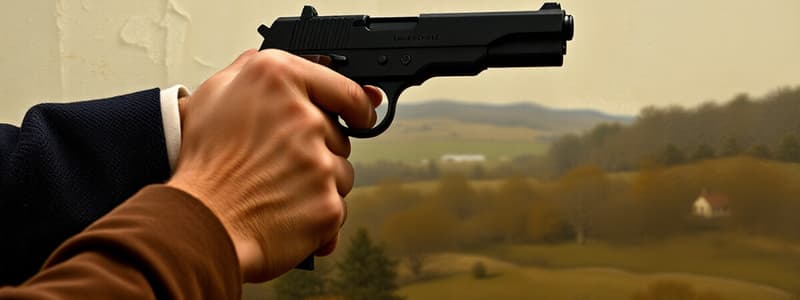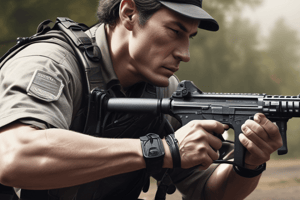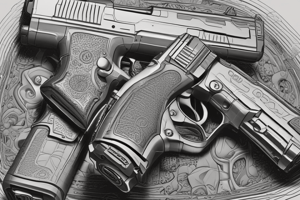Podcast
Questions and Answers
What is the primary objective during a handgun defense technique?
What is the primary objective during a handgun defense technique?
- To get the muzzle pointed away from you (correct)
- To disarm the subject completely
- To ensure backup is present
- To verbally distract the subject before moving
Which factor is NOT considered when employing handgun defense techniques?
Which factor is NOT considered when employing handgun defense techniques?
- The presence of other potential victims
- The effectiveness of verbal distraction (correct)
- The proximity of the officer to the subject
- The officer's belief that the subject will shoot
What is the importance of speed in handgun defense techniques?
What is the importance of speed in handgun defense techniques?
- It ensures that backup arrives quickly
- It helps in maintaining surprise and taking initiative (correct)
- It enables the officer to communicate with the subject
- It allows for more time to assess the situation
Why is telegraphing considered detrimental in handgun defense?
Why is telegraphing considered detrimental in handgun defense?
What is a potential consequence of grabbing a revolver with the hammer cocked?
What is a potential consequence of grabbing a revolver with the hammer cocked?
Which principle utilizes asking the subject a question before taking action?
Which principle utilizes asking the subject a question before taking action?
What must happen for a handgun defense technique to be initiated?
What must happen for a handgun defense technique to be initiated?
What critical factor allows the officer to be the initiator in a defense situation?
What critical factor allows the officer to be the initiator in a defense situation?
Flashcards
Handgun Defense
Handgun Defense
A last-resort technique used when an officer believes a subject with a handgun is about to shoot them.
Telegraphing
Telegraphing
Revealing one's intentions through subtle body movements (e.g., eye, hand, foot movements).
Surprise (in Defense)
Surprise (in Defense)
Critically important in handgun defense; the attacker must not know your intentions.
Physical Proximity
Physical Proximity
Signup and view all the flashcards
Verbal Distraction
Verbal Distraction
Signup and view all the flashcards
Revolver Tactics
Revolver Tactics
Signup and view all the flashcards
Semi-automatic Tactics
Semi-automatic Tactics
Signup and view all the flashcards
Handgun Cycle
Handgun Cycle
Signup and view all the flashcards
Study Notes
Handgun Defense Techniques
- Handgun defense is a last resort used when an officer believes a subject with a handgun is about to shoot them.
- Several factors influence the decision to use handgun defense:
- Proximity between the officer and subject
- Officer's belief the subject will shoot them
- Presence of other potential victims
- Other reasonable options
- Mindset of commitment to challenge the subject, even if there's risk of injury.
Principles of Effective Techniques
- Surprise: Avoid telegraphing actions (not revealing intentions through body language)
- Action is Faster than Reaction: The officer is the initiator, and the subject must respond to the threat.
- Verbal Distraction: Providing multiple pieces of information at once slows down reaction time.
- Physical Proximity: The subject's handgun must be within arm's reach to initiate the technique.
Handgun Cycles of Operation
- Revolvers: Cocking the hammer or grabbing the cylinder can stop the weapon from firing.
- Semi-automatic pistols: Grabbing the upper part of the pistol can stop the cycling, but one shot might still fire, causing temporary flash blindness, and making the barrel very hot.
General Guidelines for Close Proximity Encounters
- Moving out of the way: Position one's body to avoid the threat.
- Controlling the weapon: Taking control of the subject's weapon.
- Following up with appropriate actions: Acting based on the encounter.
- Multiple positions: Defense techniques can be performed while standing or on the ground.
Other Considerations
- Handgun defense techniques are also applicable in cases involving long guns.
- The primary goal is to point the weapon away from yourself.
Studying That Suits You
Use AI to generate personalized quizzes and flashcards to suit your learning preferences.


